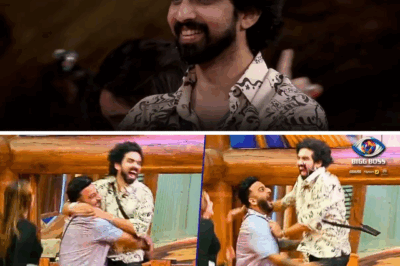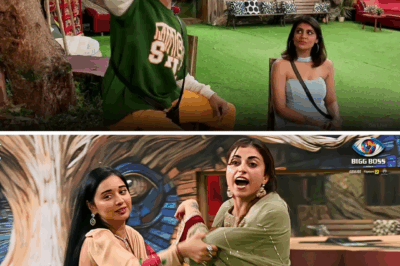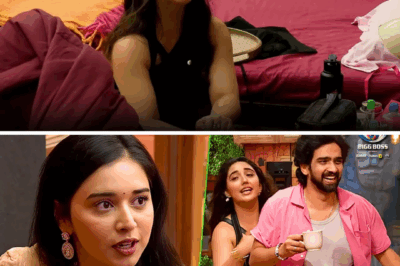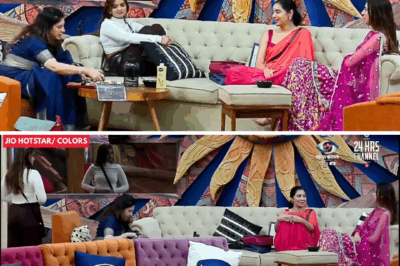Bigg Boss 19 is no stranger to drama, but the recent incident involving Ashnoor and Tanya has taken the tension in the house to an entirely new level. What began as a playful mimicry quickly turned into one of the most talked-about confrontations of the season. Ashnoor, known for her bold personality and sharp wit, decided to imitate Tanya’s gestures, expressions, and signature mannerisms during a group activity. While some housemates laughed, others, most notably Amaal, were visibly irritated, setting the stage for a high-voltage conflict.
The incident occurred during a casual task when contestants were asked to perform light-hearted activities to showcase their creativity and personality. Ashnoor, spotting an opportunity to entertain, chose Tanya as the target of her mimicry. Every gesture, facial expression, and quirky habit was exaggerated for comedic effect. Initially, the mimicry drew laughter from certain housemates, including the younger contestants who found the performance humorous and harmless. However, not everyone shared the same sentiment.
Amaal, who shares a close bond with Tanya, immediately perceived the mimicry as disrespectful and disrespecting the trust within the house. His reaction was swift and sharp, confronting Ashnoor in front of everyone. The playful act had instantly escalated into a confrontation, with voices raised and accusations exchanged. What could have been a fleeting moment of fun became a highly charged emotional episode, highlighting the fragile balance of humor, respect, and personal boundaries in the Bigg Boss house.
Fans watching at home were quick to react. Clips of the mimicry and the ensuing confrontation went viral within minutes. Social media platforms were flooded with reactions, debates, and fan theories. Viewers were divided: some thought Ashnoor’s mimicry was a harmless act of entertainment, while others felt it crossed a line and deserved Amaal’s angry response. Hashtags related to the incident began trending, with fans passionately discussing the morality, strategy, and consequences of the act.
Inside the house, the atmosphere became tense immediately after the confrontation. Housemates who were previously neutral started picking sides, creating new alliances and fueling existing rivalries. Some defended Ashnoor, arguing that mimicry was a natural part of entertainment and that humor should be taken lightly. Others sided with Amaal, emphasizing the importance of respecting boundaries and not mocking fellow contestants. This division further heightened the emotional stakes, ensuring that the incident would influence house dynamics long after the initial mimicry.
The mimicry incident also revealed deeper layers of strategy. Ashnoor, whether intentionally or not, highlighted power dynamics in the house. By choosing Tanya, a contestant admired by many, she indirectly challenged authority, confidence, and alliances. Amaal’s protective stance not only defended Tanya but also reinforced his position as a key player who could influence house sentiments. What seemed like a small act of humor evolved into a strategic battle, blending entertainment, personal emotions, and game tactics.
Confession room sessions added more insight into the minds of the housemates. Ashnoor admitted to trying to lighten the mood and entertain the audience but seemed taken aback by the intensity of Amaal’s reaction. Tanya, on the other hand, remained calm publicly but expressed private discomfort, revealing that even minor mimicry could trigger feelings of disrespect when combined with the high-pressure environment of the Bigg Boss house. Amaal’s reaction, though protective, showed the depth of emotional investment and the seriousness with which alliances and respect are maintained.
The episode also highlighted how humor can serve as a double-edged sword in reality TV. While Ashnoor’s intent was comedic, the context of mimicry in a competitive environment amplified emotional responses. Every exaggerated gesture, every playful expression, and every shared laugh carried an unspoken weight. Contestants had to balance entertainment with personal sensitivity, a challenge made more difficult by the constant surveillance, intense competition, and ever-changing social dynamics.
Fans were quick to notice subtle signs of tension that had been building up for weeks. Ashnoor’s bold personality had already created friction with some housemates, and this mimicry acted as a catalyst for emotional release. Amaal, who had been observing shifts in alliances and interpersonal dynamics, chose this moment to assert boundaries, creating a confrontation that resonated deeply with viewers. The mimicry, seemingly trivial, became a microcosm of power, strategy, and emotion in the Bigg Boss house.
Social media engagement skyrocketed. Clips of the mimicry, Amaal’s reaction, and housemates’ responses circulated widely, drawing millions of views within hours. Fans debated whether Ashnoor intended to provoke, entertain, or strategically challenge Tanya and Amaal. Analysts and commentators discussed the psychological aspects of the confrontation, noting how mimicry, humor, and perception can influence emotional reactions and game strategy. Memes and reaction videos turned the incident into a cultural moment within the Bigg Boss fandom.
The mimicry incident had lasting consequences for house dynamics. Contestants who had been neutral now found themselves forced to choose sides, alliances shifted, and trust was tested. The confrontation also served as a reminder that every action, no matter how seemingly minor, could carry weight in the Bigg Boss house. Emotional intelligence, conflict management, and awareness of social boundaries became crucial survival tools in the intense, scrutinized environment.
As the day ended, the house was buzzing with whispers, speculation, and tension. Ashnoor reflected on her actions, acknowledging that humor in Bigg Boss is a delicate balance. Tanya processed the incident with a mix of amusement and mild annoyance, understanding the competitive and emotional context. Amaal maintained his stance as the protector and strategist, signaling that house dynamics had shifted in subtle but significant ways.
Ultimately, the mimicry incident is more than a funny moment; it’s a testament to the intricate social game of Bigg Boss 19. Humor, emotion, and strategy collide in unexpected ways, transforming small actions into major events. Fans and contestants alike are reminded that in this house, nothing is truly trivial—every gesture, laugh, and reaction carries consequences that echo far beyond the immediate moment.
The aftermath of Ashnoor’s mimicry of Tanya quickly escalated into one of the most dramatic episodes of Bigg Boss 19. What started as playful entertainment became a catalyst for intense arguments, strategic calculations, and new alliances forming behind the scenes. The house, usually buzzing with energy and camaraderie, now felt like a pressure cooker, with emotions running high and egos clashing at every turn.
Amaal, still visibly upset from the mimicry, confronted Ashnoor again, this time in a more heated exchange. Voices were raised, accusations flew, and the argument quickly drew the attention of other housemates. Some contestants tried to mediate, urging calm and fairness, while others fueled the fire, aligning themselves either with Amaal’s protective stance or Ashnoor’s bold approach. The tension created an unpredictable environment where every reaction had consequences.
Other contestants seized the opportunity to voice grievances that had been simmering for days. Previous small conflicts, hidden jealousies, and rivalries resurfaced, amplified by the mimicry incident. Housemates who had been quiet strategists suddenly found themselves embroiled in the confrontation, revealing layers of the game that had previously remained invisible. The mimicry became a flashpoint, triggering a domino effect of arguments, mistrust, and shifting alliances.
Backstage, in the confession room, contestants reflected on the confrontation and revealed their true feelings. Ashnoor expressed surprise at the intensity of the reaction, explaining that her mimicry was intended purely for entertainment and not to disrespect anyone. Tanya admitted that while she initially found it amusing, the continued commentary and attention made her uncomfortable. Amaal, meanwhile, justified his anger, emphasizing that respect and personal boundaries in the house are non-negotiable. These insights highlighted the complex interplay of humor, perception, and emotional intelligence in the Bigg Boss environment.
The arguments were not limited to the mimicry itself. Strategic discussions among housemates revealed that the incident had implications for future tasks, captaincy, and nominations. Those siding with Amaal positioned themselves as protectors of house values, while Ashnoor’s allies highlighted the importance of humor, creativity, and audience entertainment. This divergence of priorities created new layers of strategy, where personal emotions intersected with gameplay, and alliances were continually tested.
Several key moments intensified the drama. One housemate accused Ashnoor of deliberately provoking Tanya to destabilize Amaal, suggesting a hidden strategic motive behind the mimicry. Another pointed out that humor is subjective and defended Ashnoor’s right to entertain. The clash between emotional reactions and strategic reasoning became a central theme, capturing the attention of viewers and keeping the house on edge.
Social media exploded with reactions to the escalating conflict. Fans dissected every argument, gesture, and expression, forming polarized opinions. Some praised Amaal for defending Tanya, calling him a loyal and principled contestant. Others applauded Ashnoor for boldness and comedic timing, arguing that humor is essential to the entertainment factor in Bigg Boss. Memes, reaction videos, and detailed analyses flooded platforms, further intensifying the buzz around the mimicry incident.
The mimicry episode also exposed underlying power dynamics in the house. Amaal’s response positioned him as a dominant force capable of influencing sentiments and shaping alliances. Ashnoor, on the other hand, demonstrated that bold actions can draw attention, provoke reactions, and strategically alter perceptions. The clash highlighted how every action, whether comedic or confrontational, is magnified under the constant gaze of cameras and the scrutiny of millions of viewers.
By the end of the day, the house was divided. Contestants had taken sides, alliances had shifted, and trust levels were recalibrated. Those who initially appeared neutral found themselves drawn into debates, forced to take a stand. The mimicry, seemingly lighthearted, had catalyzed a full-blown social game, revealing the fragility of relationships and the intensity of emotional investments in Bigg Boss 19.
The aftermath also impacted upcoming tasks and interactions. Housemates were now hyper-aware of their words, gestures, and strategies. Every joke, comment, or playful act could potentially escalate into conflict, influencing gameplay and social standing. The mimicry incident served as a lesson in the delicate balance between humor, respect, and strategy—an ever-present challenge in a house where emotions run high and alliances are constantly tested.
From a viewer perspective, the incident became a case study in reality TV dynamics. Analysts highlighted how mimicry, perception, and personal bonds interact in high-pressure environments. The Bigg Boss audience engaged deeply, predicting future conflicts, alliance shifts, and strategic maneuvers. This convergence of entertainment, strategy, and emotion underscored why Bigg Boss 19 continues to captivate millions, blending raw human behavior with unpredictable drama.
Ultimately, Part 2 of the story showcased how a seemingly minor mimicry could escalate into multi-layered conflict. Arguments, emotional reactions, and strategic maneuvering combined to create an episode that fans will remember for its intensity. The dynamics in the house were permanently altered, with new rivalries, alliances, and emotional tensions shaping future interactions and tasks.
The mimicry incident highlighted the dual nature of Bigg Boss 19: it is simultaneously a game of strategy and a reflection of human emotions. Contestants must navigate humor, respect, personal relationships, and strategic ambitions, all under constant scrutiny. In this environment, even a single act of mimicry can ripple through the house, influencing gameplay, social dynamics, and audience engagement for weeks to come.
The chaos sparked by Ashnoor’s mimicry of Tanya continued to ripple through the Bigg Boss 19 house, even after the initial confrontation had ended. While contestants were still processing the events, fans outside the house reacted with unprecedented intensity. Clips of Ashnoor’s mimicry, Amaal’s angry response, and the heated arguments quickly went viral, flooding social media platforms with debates, memes, and fan theories. The episode became one of the most discussed moments of the season, demonstrating the power of a single act to ignite both house and audience drama.
Social media platforms were abuzz with polarized opinions. Some viewers praised Amaal for defending Tanya, framing him as a loyal, principled contestant standing up for fairness and respect. Others applauded Ashnoor for her courage, wit, and ability to entertain under the pressure of the cameras. Hashtags related to the incident trended within hours, sparking thousands of comments and discussion threads. Fans dissected every expression, every gesture, and every word, debating intentions, consequences, and potential future outcomes.
The mimicry incident also provided a rich source for analysis among commentators and entertainment bloggers. Experts pointed out that humor in a competitive, high-pressure environment like Bigg Boss is always double-edged. What seems playful can quickly trigger offense, tension, and strategic maneuvering. Ashnoor’s actions, though intended for comedy, illuminated the delicate balance between entertainment and respect in the house, while Amaal’s response demonstrated how emotional investment and loyalty shape conflict resolution in reality TV.
Inside the house, the emotional fallout was palpable. Contestants reflected privately in the confession room, sharing feelings of frustration, amusement, and apprehension. Ashnoor admitted she hadn’t anticipated such an intense response and expressed regret for unintentionally escalating tensions. Tanya, meanwhile, described mixed feelings—while initially flattered by the attention, she recognized how mimicry could be perceived as disrespectful in a competitive environment. Amaal reaffirmed his stance, emphasizing that boundaries and trust are critical in a house where personal and strategic dynamics constantly intersect.
The ripple effects of the incident extended to house alliances. Those siding with Amaal solidified their positions, forming closer bonds with each other and projecting influence over neutral contestants. Ashnoor’s allies highlighted the importance of humor, creativity, and boldness, framing the mimicry as harmless entertainment. This division intensified the underlying competition, forcing contestants to navigate both emotional loyalty and strategic positioning. Minor disagreements began surfacing more frequently, and the emotional tension set the stage for future confrontations and tactical gameplay.
Fans played a key role in magnifying the impact. Reaction videos, memes, and live commentary became central to the conversation, turning the incident into a cultural moment within the Bigg Boss fandom. Each twist in the house was scrutinized, debated, and predicted, creating a feedback loop between contestants’ actions and audience perception. Fans speculated about how the mimicry might affect nominations, task outcomes, and future alliances, increasing the stakes for everyone involved.
The emotional consequences for the contestants were also significant. Ashnoor, despite her confident demeanor, experienced moments of doubt and anxiety about how her actions were perceived. Amaal, while appearing dominant, faced the pressure of maintaining authority without alienating others. Tanya had to balance her personal feelings with strategic considerations, understanding that public perception and house dynamics were now intertwined with her image. The mimicry incident had transformed into a complex web of emotional, strategic, and social challenges that would shape the weeks ahead.
The drama also highlighted broader themes of respect, humor, and strategy. Viewers and commentators observed that in Bigg Boss, even seemingly minor acts can carry heavy consequences. Contestants are constantly monitored by cameras and evaluated by peers and the audience alike, turning playful gestures into catalysts for conflict, strategy, and social maneuvering. The Ashnoor-Tanya-Amaal incident exemplified how high-pressure reality environments magnify human emotions, forcing contestants to navigate delicate interpersonal dynamics.
Looking forward, the incident sets the stage for future twists in Bigg Boss 19. Housemates will now be hyper-aware of their actions, words, and alliances. The emotional tension and strategic shifts resulting from the mimicry incident will influence nominations, leadership tasks, and interpersonal conflicts. Fans anticipate further confrontations, unexpected alliances, and strategic moves as contestants attempt to assert dominance while maintaining house harmony. The mimicry incident has reshaped the competitive landscape, creating uncertainty and heightened suspense for upcoming episodes.
Ultimately, the Ashnoor mimicry incident demonstrates why Bigg Boss 19 continues to captivate audiences. It combined humor, emotion, and strategy, transforming a seemingly trivial act into a major storyline with lasting consequences. Fans remain emotionally invested, analyzing, debating, and predicting every possible outcome. Contestants must navigate a complex landscape where humor, loyalty, and game strategy intersect under constant observation, proving that in Bigg Boss, nothing is ever truly trivial.
The episode also reinforces the unpredictable nature of reality television. A playful gesture can ignite conflict, alliances can shift in moments, and emotional stakes are always high. The housemates’ reactions, combined with fans’ passionate engagement, illustrate the intricate dynamics of Bigg Boss 19. For viewers, the mimicry incident is a lesson in how entertainment, perception, and emotion intertwine, creating a story that is both compelling and unpredictable.
As the season progresses, the aftereffects of this incident will continue to unfold. Contestants will adjust strategies, manage alliances, and anticipate future conflicts, all while navigating the emotional fallout. Fans will continue to dissect every interaction, predicting which housemates are likely to dominate, who will falter, and how tensions will shape the journey ahead. The Ashnoor mimicry moment is more than just a funny clip—it is a defining event that highlights the delicate balance of humor, respect, and strategy in the Bigg Boss 19 house.
News
Bigg Boss 19 Drama: Pranit More Returns – Tensions and Alliances Shake Up
The Bigg Boss 19 house was already simmering with tension, rivalries, and delicate alliances when the cameras caught a moment…
Bigg Boss 19 Drama: Amaal Malik Wins Captaincy Again – House Reactions Explode
The Bigg Boss 19 house had already been a whirlwind of emotions, alliances, and rivalries, but the latest episode brought…
Bigg Boss 19 Episode Drama: Farrhana and Gaurav Clash in Fiery Fight
The Bigg Boss 19 house was buzzing with energy as Episode 76 kicked off, but tension lurked beneath the surface….
Bigg Boss 19 Drama: Tanya Explodes at Ashnoor and Amaal
The Bigg Boss 19 house, already a cauldron of emotions, reached an unprecedented level of tension in Episode 75. Tanya,…
Bigg Boss 19 Drama: Episode 75 Sees Kunickaa’s Unexpected Confession Leave House in Chaos
The Bigg Boss 19 house was already simmering with tension, but nothing could have prepared the contestants—or the viewers—for the…
Bigg Boss 19 Drama: Episode 75 Reveals Tanya’s Heartbreaking Decision Against Amaal
The Bigg Boss 19 house had been buzzing with tension for days, but nothing could have prepared the contestants—or the…
End of content
No more pages to load












